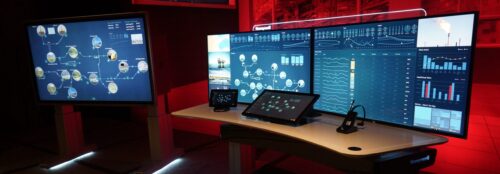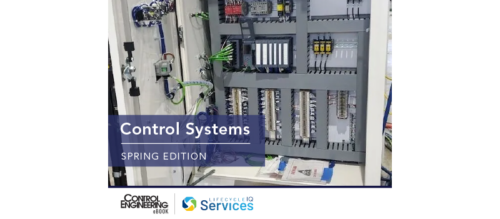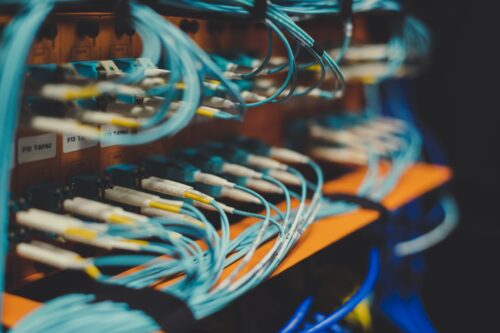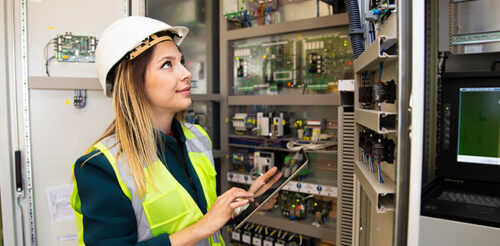When is PID Not the Answer?
Social media group member posits the question: How come PID is the answer to so many applications? Is it because advanced control is rarely needed or that control engineers are not pushing the envelope?
LINKS
To access all Control Engineering PID-related content, input “PID” into the search box atop any page at www.controleng.com .
Sidebars: Automation & Control social media forums Don’t forget advanced control basics
PID has long been one of the more popular topics covered at Control Engineering , and for good reason—our subscribers see it as an integral component of their work. The popularity of the topic among control engineers worldwide does not appear to be waning either. Looking back over the past two years, loop tuning and PID-related articles are consistently among the most popular articles visited on the Control Engineering Website.
So when Parasar Kodati, application support engineer at the MathWorks, posted this question on the Automation & Control Engineering LinkedIn site: “When PID is not the answer: What is Advanced Control good for?” a high level of response was assured.
Kodati noted that, while a graduate student, he was “amazed by the subject of control and couldn’t wait to see the applications of the theory applied in industry.” Three years after graduation, however, he began to wonder why PID seemed to be the answer for so many applications.
Members of the social media group quickly responded, and continued to do so for months after the initial post. Their responses largely broke out along three lines: why PID is right for so many applications, when advanced control is more suitable, and how to analyze a situation to determine if PID or advanced control is the best option.
The standard or ISA standard form of the PID algorithm allows a user to simultaneously adjust the contributions of all three terms by means of a single tuning parameter (Kp). The proportional, integral, and derivative actions all depend on the value of Kp; hence the alternative label dependent or dependent ideal PID. This arrangement is occasionally labeled the academic algorithm even though academicians rarely use it. Source: Control Engineering, "Sorting Out PID Controller Differences" by Vance VanDoren, February 2009.
When PID is enough
“From my experience, a great many systems have very simple dynamics, and in these situations PID is often sufficient to provide the performance needed,” said Doug Harriman, senior mechatronics engineer at Hewlett-Packard. “PID controllers can be more intuitive to tune. It’s easier to reason out the expected behavior when changing one of the PID gains than it is to think about pole placement.”
He also noted that, since most engineers “never take any advanced control theory,” this could be another reason behind PID’s popularity.
Kareem Suhwail, systems engineer at RoviSys, says that, from an automation perspective, PID is more than enough for 99% of control situations. “Realize that, while studying advanced controls, you are often given transfer functions, block diagrams, state equations, etc., it is virtually impossible to model a running production line with these and it is unrealistic to perform an expensive advanced control analysis for the small gains it would give you over PID,” he said.
“Most control loops in the chemical industry, while non-linear to some degree, are linear enough in the normal control region near setpoint” for which PID works fine, said Joseph Alford, a consultant with Automation Consulting Services. It may not be not optimal control, but it’s good enough.
Alford also echoed Harriman’s comments that most engineers typically do not take more than one undergraduate control course and so “have only been trained on PID and a few related simple control configurations (e.g., cascade).” Add to the education factor PID’s simplicity and off-the-shelf availability, and you have three very big reasons for PID’s dominance in control applications.
In another part of his comment, Alford referred to a survey he had seen which indicated that audits of many industrial control loops using model-based or other complex control strategies often had the loops set in manual mode. Alford said this was often the case after the engineer who designed the advanced control strategy had moved on to another assignment. This indicates that, for most engineers, it is “difficult to maintain continuous support of complex control loops when new support people are not familiar with the control algorithm. There are probably also validation issues regarding complex control algorithms in highly regulated industries such as pharmaceutical, biotech, medical devices, and nuclear,” said Alford.
Though many industrial processes are becoming more challenging, Thomas Swift, an industrial automation and control professional, says that PID remains his tool of choice for most of the control issues he encounters. Even in many advanced applications, “classical methods such as feed forward and cascaded feedback are, in my experience, much preferred to increasing the complexity of the core control algorithm,” he said.
The secret to the success of PID-based control architectures (such as ratio control, cascade control, and feedforward control), according to Massimiliano Veronesi, product marketing manager at Yokogawa, are the low cost/high benefit ratio they provide. “It is not always easy to measure the performance improvement provided by [advanced] control strategies and translate it into a real return on investment.”
CO(t) is the controller’s current output; e(t) = SP – PV(t) is the error between the set point (SP) and the process variable PV(t); P is the controller gain; T1 is the integral time TD is the derivative time. Source: Control Engineering, "Loop Tuning Fundamentals," by Vance VanDoren, July 2003
Alternate options
While most respondents agree that PID is good enough for most control applications, what about those instances when it’s not good enough? What then are the best options engineers should learn more about in order to consider them for application?
“PID only, in its simplest form, is not enough for position control for extremely dynamic or second order systems,” said Richard Meyerhoefer, sales manager at Delta Computer Systems Inc. “Advanced algorithms are available that will create a system model and automatically calculate additional gains such as velocity feed forwards, acceleration and deceleration feed forwards, jerk feed forwards, and double derivatives. These advanced gains are based upon natural frequencies. PID is used to correct for non-linearity. Feed forwards should be able to correct for 90% of the error. In these cases, [only using] PID leads to very unstable systems.”
Meyerhoefer adds that it is often a lack of understanding on the part of many engineers that lead them to abandon closed loop control options in favor of more mechanical options. Unfortunately, in many instances, these options often lead to a lack of repeatability, lower resolution, and increased down time.
PID coupled with Smith Predictor can address simple transport delays easily, according to Sergei Kuznetsov, principal control systems engineer at The Automation Group. He noted that he has seen Smith Predictor used for a wood chip level control that had been working in manual mode for more than 20 years. “The client ended up saving $1.5 million dollars in raw material costs annually (about 7%),” Kuznetsov said.
“Model-based control is clearly a superior approach, from the standpoint of responsiveness, following errors and settle time, in those situations where it can be applied,” said Michael Thompson, principal development analyst at The Timken Co. “However, model-based control often requires additional terms in the feedback loop. For example, if I am trying to change the temperature of a volume of liquid in a storage container, it definitely helps to know how much liquid is present in addition to the temperature of the liquid. Charging a battery is a similar problem. It helps to know how much charge it already has. Sometimes that information is not so easy to determine from the available sensors.”
There are also many situations where non-linear gain scheduling can be effectively employed in a PID control-loop without additional sensors or significant complexity, according to Thompson. In such cases, the gain-scheduling may simply be a transfer function that maps a non-linear variable to a more linear one. In these cases, the PID controller would act the same.
Application advice
Regardless of whether PID is adequate for most applications or not, the only thing that really matters from an engineering perspective is which control method will provide the optimal result for the particular application the engineer happens to be working on at the time. This next set of advice from practicing engineers addressed just that.
As a starting point, Igor Begelfor, instrument package engineer at AMEC, suggests that when PID does not work, start looking at the field measurement and control devices, as they have likely been misapplied. Once you’ve eliminated these as the problem and concluded that PID may not provide the optimal control for your project, it’s time to start looking closely at the application.
Recalling work on systems with extensive higher order dynamics that needed to meet stringent stability and tracking requirements, Hai Ho, vice president of engineering and product development at HID Global, noted his use of multi-variable state space, adaptive, and learning control methods rather than PID. The systems requiring this advanced level of control were: a digital flight control system for satellite missiles; and controlling the position of a magnetic read/write head to the micro-inch accuracy under wind disturbance conditions equivalent to a category 4 hurricane.
Offering a more practical example using non-linear gain scheduling, consider the problem of a scanning CMM (coordinate measuring machine), suggested Michael Thompson, principal development analyst at The Timken Co. “During scanning of the surfaces, the axes of the machine are controlled using feedback from a probe. However, most probes only provide feedback over a very narrow range. A contact-based probe cannot provide useful feedback when it is not in contact with the surface or when it is over deflected. Also, these machines generally try to scan the surface with minimal probing forces (for reduced wear, less deformation of the surface, and greater accuracy). So the control problem is highly asymmetric,” he said.
“Near the target force/deflection (when error is nearly zero), acceptable and stable control can be achieved with linear gains and standard PID control. But when the probe is undeflected, the error signal is low (because of the low target force) so you must rely on heavy integral gain in order to achieve a reasonable approach velocity,” Thompson said. “That heavy integral control is not necessarily desirable once the probe is in contact with the part. In fact, the integrator wind up in such a case can lead to over-deflection of the probe during overshoot after the probe makes contact. Likewise, if the probe approaches an over-deflection condition, it is desirable to drive it much harder than normal in order to avoid the over-deflection.”
One technique that Thompson said he has used to address these problems is to “apply control action that is proportional to the cube of the error term in addition to the normal (linear) proportional control. The cube is used to maintain the sign of the error term. To address the asymmetry, I chose to toggle the gain sets depending on whether the probe was minimally deflected or not, but a quadratic term could also be used to create asymmetry. One reason why I have preferred to toggle the gain sets is due to the fact that the damping of the probe changes when it is in contact with the surface.”
Ultimately, Thompson says the gains are chosen so that there is a linear region around zero error. “Via non-linearity (cubic and quadratic for example), the transfer function is made much stronger than normal when the probe approaches an undeflected or over-deflected condition,” he said. “The stronger response in these regions would not be stable if it was applied linearly throughout the range of probe deflection. Therefore, the zero-error condition becomes a region of stability where gains are sufficiently low to avoid instability.”
Final analysis
Helping to encapsulate this wide-ranging discussion, one post in particular got to the core of the issue as it pertains to the day-to-day duties of a control engineer.
Thomas Stevic, a controls engineer at DMAX, said that when designing a solution to a problem, he finds that he typically has two masters to serve. The first master is the person who is responsible for the output of his design. This is often “the person who pays the bills,” Stevic said. “These people usually do not care how a machine or process works. Their concern is: Does the machine make what it is supposed to make? While exotic solutions may increase quality, decrease production time, make better use of resources and, from an engineering viewpoint, be very cool to use and inch closer to perfection, their use is not often a benefit to the first master.”
The second master is described by Stevic as the person or people who will “maintain the system after I am gone. Ultimately, my designs have to address the least capable people who may be required to maintain or modify my design.”
Given the requirements of the second master, Stevic says that, given a choice between using adaptive neural network control or a thermostat, if the thermostat will work, that is what he will choose. “If neural nets or fuzzy logic are required to produce the desired result, I will use them, but only after examining the simpler solutions,” he said.
Also read, from Control Engineering :
– PID control analogy, revisited – TalkBack commentary from readers ;- Understanding the Derivative in PID Control ;- Real-World Applications of Advanced Process Controls .- Advanced Control Software Goes Beyond PID .
Author Information
David Greenfield is editorial director. Reach him at david.greenfield@reedbusiness.com .
Automation & Control social media forums
To become a part of the conversation or merely follow the “Automation & Control” discussions in real-time, access the forums on Facebook and LinkedIn via the following links:
Automation & Control Engineering group on LinkedIn: https://tinyurl.com/y8tckah
Automation & Control group on Facebook: https://tinyurl.com/yk43xmf
Don’t forget advanced control basics
While it’s tempting to apply any number of advanced control methods to optimize a given process to its ultimate in performance, the reality is that most processes—and process owners—do not require that level of control. If the control method can’t deliver in terms of cost and quality improvements, it’s usually not the answer you need.
To keep your control method decisions as useful as possible, George Buckbee, vice president of marketing and product development at ExperTune Inc., offers these four checkpoints:
Realize that the control hardware in an existing plant is often in bad condition. A typical process plant can expect about 30% of control valves to have mechanical issues, says Buckbee. “If you have sticky control valves, noisy instrumentation, or poor installations, then it doesn’t really matter what type of controller you have. You will still have poor performance.”
Have reasonable expectations. If a loop has large dead time, then you won’t get great control from any feedback controller because feedback control is like driving your car by looking in the rearview mirror.
Most plant personnel don’t know how well their existing controls are performing. “I’ve personally been in hundreds of plants, and typically 30% of PID loops are running in manual mode, and nobody knew it,” said Buckbee. He adds that control loop monitoring software can be used to diagnose and give visibility to instrument, valve, and control performance.
Focus on the root cause of process upsets. “I have seen many plants installing model predictive control on distillation columns, when the fundamental problem is process upsets coming from utilities. You’ll often get a better return on investment from stabilizing the boiler plant operations,” he said. The trick is to be able to analyze the data for root cause.
Do you have experience and expertise with the topics mentioned in this content? You should consider contributing to our CFE Media editorial team and getting the recognition you and your company deserve. Click here to start this process.





